
As mentioned previously, we drove to the Virginia Beach KOA on Fri. to spend Memorial weekend. The place was already busy when we arrived and filled up quickly. The folks across from us were visiting from PA and brought their dog along who got a ride in this special buggy! The campground had a number of activities planned for the weekend with most geared towards kids (of which there were plenty). We did walk up to the pavilion Sat. night to listen to Renee Mixon (
http://reneemixon.com/),

a singer/songwriter from Rome, GA. Her songs are what I’d call folk/pop, and she has a really nice voice. She recently cut her 3rd CD, and you can listen to some of her music on her website. Scott and I walked up for the wine tasting on Sun. evening, but it left a lot to be desired. A lady had 5 bottles of different wines for you to sample about an inch-worth, but none on hand to purchase….it’s all mail order. (Not a simple thing to do when your house moves constantly.) I sampled 3, Scott sampled 2, and it took all of about 10 minutes. The swimming pool was always packed with kids but with my head boo-boo, I couldn’t really swim anyway, and we figured the beach would be way too crowded to visit. So we pretty much just hung out for the weekend, chatting with folks….except for Sat.
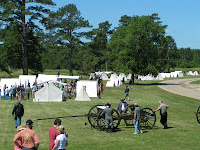
Our original plan had been to visit the Yorktown National Battlefield when we arrived in Williamsburg for our stay there because it’s not far from Yorktown. Normally the Battlefield’s focus is on the Revolutionary War, but we found out that it was Civil War Weekend this particular weekend complete with tactical demonstrations, encampments, campfire p
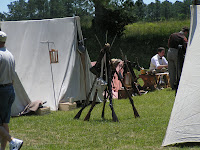
rograms, and the telling of the role Yorktown played during the Civil War. The trip would be 50 miles one way, but we decided it was something we all wanted to experience so that’s where we headed on Sat. Most people don’t realize that more major battles during the Civil War took place in Virginia, the Capital of the Confederacy, than in any other state.

The Battlefield is part of the Colonial National Historical Park operated by the National Park Service, and all participants were in period costume. We arrived in time to catch the last few minutes of the Confederate Infantry demonstration.


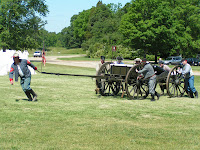 Then it was time for the Confederate Artillery demonstration. The sergeant began by explaining the different types of shells used and how they all worked, and then he explained each gunner’s position and responsibility at the cannon. It was now time for the firing demonstration, and it was loud! They did two firings and then explained that they had slowed down the process so we could see what all it entailed, but in war they would be able to fire 3 rounds per minute, which seemed amazing with all the process required to fire just one round.
Then it was time for the Confederate Artillery demonstration. The sergeant began by explaining the different types of shells used and how they all worked, and then he explained each gunner’s position and responsibility at the cannon. It was now time for the firing demonstration, and it was loud! They did two firings and then explained that they had slowed down the process so we could see what all it entailed, but in war they would be able to fire 3 rounds per minute, which seemed amazing with all the process required to fire just one round.
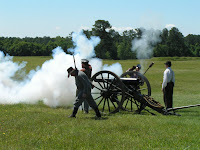
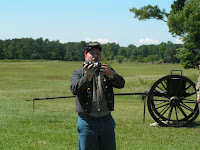

Afterwards we walked over towards the encampment and spoke with a Union soldier who I had stopped to ask about the very weathered, old flag the encampment was flying. As it turns out the flag is only 10-15 years old but is an exact replica of the one flown during the war made of silk as was the custom then. He said they've been considering replacing it with a cot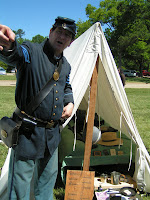 ton flag because they are more durable, but it would not be in keeping with the authenticity so the debate continues. These re-enactors all belong to regiments throughout the U.S. and perform these demonstrations and/or re-enactments a couple times a month. The soldier we were speaking with was from a Maine regiment and had spent the night in his tent, as did all the others. He was the only one in his tent that night and had the luxury of a cot but explained that during the war 6 men would
ton flag because they are more durable, but it would not be in keeping with the authenticity so the debate continues. These re-enactors all belong to regiments throughout the U.S. and perform these demonstrations and/or re-enactments a couple times a month. The soldier we were speaking with was from a Maine regiment and had spent the night in his tent, as did all the others. He was the only one in his tent that night and had the luxury of a cot but explained that during the war 6 men would 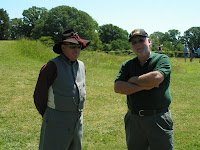 have shared that tent lying side by side! You can see in the photo just how small the tent is. He said that in the winter it was great for keeping warm but also spread disease quickly because if one guy was sick, all the rest in the tent would get sick, and that’s one reason why more men died from disease than from gunfire. Russ also chatted with the sergeant in charge of the artillery demonstration (ok, so the guy was o
have shared that tent lying side by side! You can see in the photo just how small the tent is. He said that in the winter it was great for keeping warm but also spread disease quickly because if one guy was sick, all the rest in the tent would get sick, and that’s one reason why more men died from disease than from gunfire. Russ also chatted with the sergeant in charge of the artillery demonstration (ok, so the guy was o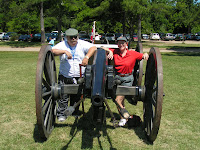 ut of uniform with his modern sunglasses!) He explained that his unit belonged to the North-South Skirmish Association (http://www.n-ssa.org/) and promotes the shooting of Civil War firearms and artillery and encourages the preservation and display of Civil War materials. They also hold skirmishes regionally and nationally consisting of competitive, live firing of these Civil War firearms and artillery. I walked over for a minute and listened to the doctor/surgeon who had some fascinating facts to relate and a lot of “tools of the trade” on his table. On our way back over to the demonstration field, we stopped to listen to a soldier playing his fife.
ut of uniform with his modern sunglasses!) He explained that his unit belonged to the North-South Skirmish Association (http://www.n-ssa.org/) and promotes the shooting of Civil War firearms and artillery and encourages the preservation and display of Civil War materials. They also hold skirmishes regionally and nationally consisting of competitive, live firing of these Civil War firearms and artillery. I walked over for a minute and listened to the doctor/surgeon who had some fascinating facts to relate and a lot of “tools of the trade” on his table. On our way back over to the demonstration field, we stopped to listen to a soldier playing his fife.

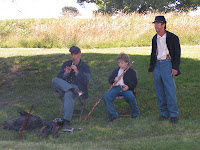

It was now time for the Union Cavalry, who demonstrated the various weapons and techniques used during that period including carbine, revolver, and sword. These demonstrations were done without the horses as at some point during the fighting the soldiers would have dismounted to continue the fighting on foot. The sergeant explained that it would generally take 2 years to properly and fully train a cavalry soldier.



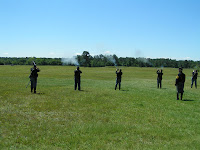

Then it was time for the Confederate Cavalry who arrived on horseback. What a sight! They were introduced by one of the ladies from town who, as she explained, would come out to the field in their nicest finery to encourage the troops. They went through a few maneuvers including the famed
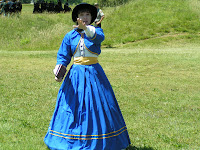
rebel yell charge, and at one point they demonstrated dismounting and firing their weapons. As was explained, they generally were grouped in fours with the best horseman not dismounting as he would hold the reins of and keep control of the other three horses. You can find more information on this particular regiment at
http://www.secondcavalry.org/. When they finished, the rid
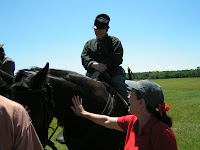
ers brought the horses over to the rope line to meet and greet their public, and I got to meet Buddy up close and personal!

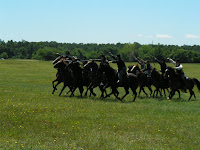


Since we were here at a site of the Revolutionary War, we switched gears and went inside to watch a 15 minute film called “The Siege of Yorktown”. Then it was back outside where we found a picnic table and ate some cold KFC that Scott had picked up the night before. And as long as we were already here at Yorktown, we decided to drive the self-guided tour through the battlefield. Our first stop was at the Yorktown Victory Monument, which commemorates the last major battle of the American Revolution, and then stopped at the Yorktown National Cemetery, where many Civil War soldiers are buried. Of the 2,183 bu
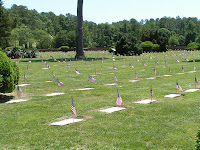
rials, 2/3 of the remains are unknown. Only 747 are identified. The drive continues along the British and Allied defense lines on to Surrender Field, where the British troops laid down their arms, surrendering 8,300 troops and effectively ending the American Revolution. The French were an instrumental ally in the war and near the French Artillery Park is the French Cemetery where the remains of approximately 50 unknown French soldiers are buried.
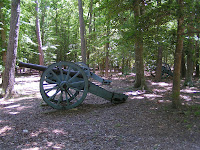
The campground really emptied out on Mon., but we had chosen to leave the next day for the KOA in Williamsburg, VA, to avoid some of the holiday traffic. From there we’ll be able to visit more of the colonial era at Williamsburg and Jamestown.
Then it was time for the Confederate Artillery demonstration. The sergeant began by explaining the different types of shells used and how they all worked, and then he explained each gunner’s position and responsibility at the cannon. It was now time for the firing demonstration, and it was loud! They did two firings and then explained that they had slowed down the process so we could see what all it entailed, but in war they would be able to fire 3 rounds per minute, which seemed amazing with all the process required to fire just one round.
ton flag because they are more durable, but it would not be in keeping with the authenticity so the debate continues. These re-enactors all belong to regiments throughout the U.S. and perform these demonstrations and/or re-enactments a couple times a month. The soldier we were speaking with was from a Maine regiment and had spent the night in his tent, as did all the others. He was the only one in his tent that night and had the luxury of a cot but explained that during the war 6 men would
have shared that tent lying side by side! You can see in the photo just how small the tent is. He said that in the winter it was great for keeping warm but also spread disease quickly because if one guy was sick, all the rest in the tent would get sick, and that’s one reason why more men died from disease than from gunfire. Russ also chatted with the sergeant in charge of the artillery demonstration (ok, so the guy was o
ut of uniform with his modern sunglasses!) He explained that his unit belonged to the North-South Skirmish Association (http://www.n-ssa.org/) and promotes the shooting of Civil War firearms and artillery and encourages the preservation and display of Civil War materials. They also hold skirmishes regionally and nationally consisting of competitive, live firing of these Civil War firearms and artillery. I walked over for a minute and listened to the doctor/surgeon who had some fascinating facts to relate and a lot of “tools of the trade” on his table. On our way back over to the demonstration field, we stopped to listen to a soldier playing his fife.

No comments:
Post a Comment